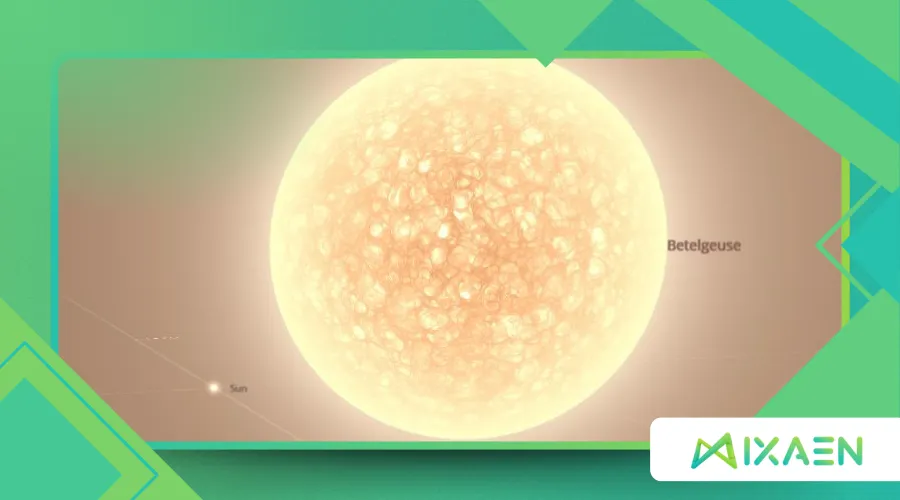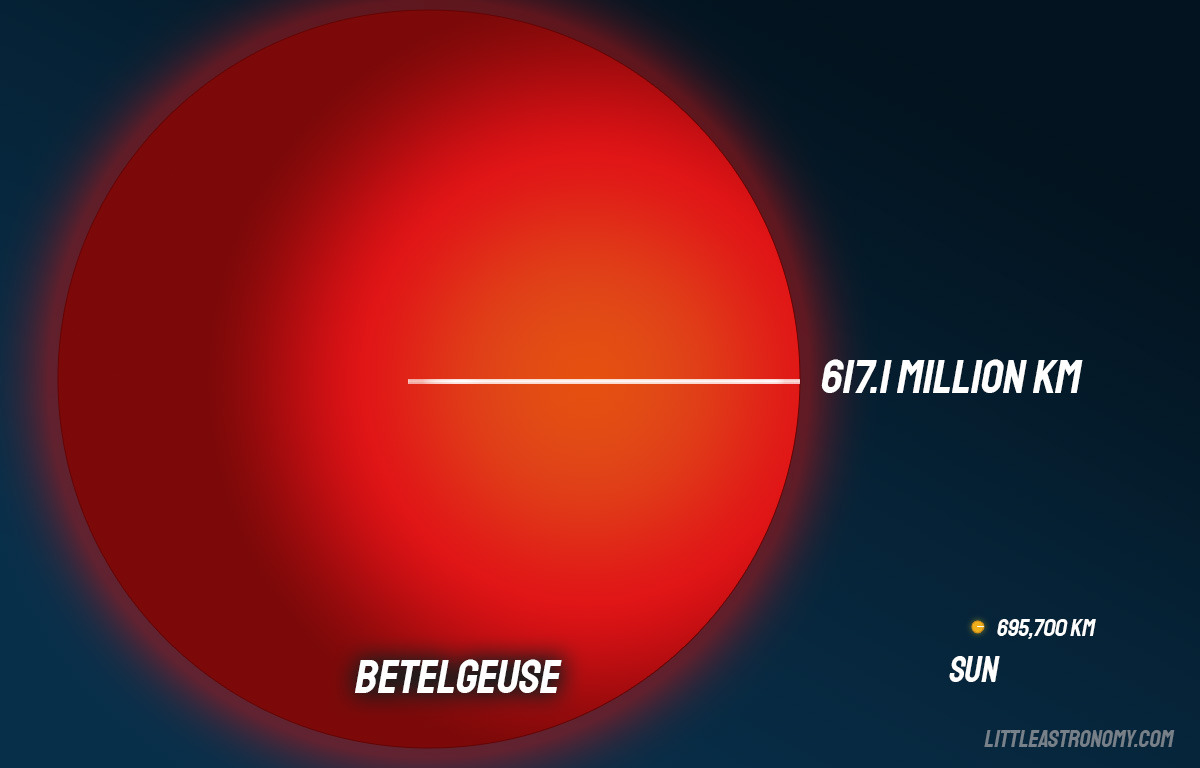Betelgeuse vs Sun: How Would Our Planet Be Affected by This Change?

The comparison between Betelgeuse vs Sun isn’t just a matter of size or brightness; it’s a thought experiment that challenges our understanding of stellar evolution and its impact on Earth.
Anúncios
What if our Sun were replaced by Betelgeuse, the red supergiant in Orion’s constellation?
How would this colossal swap alter life on our planet?
Let’s explore this fascinating scenario, blending astronomy, physics, and a touch of speculative science.
The implications of such a change extend beyond mere physical characteristics.
They also involve the potential for new forms of life, adaptation, and the resilience of ecosystems under extreme conditions.
The Stellar Giants: A Tale of Two Stars
At first glance, the Betelgeuse vs Sun comparison seems almost unfair.
The Sun, our life-giving star, is a relatively modest G-type main-sequence star, while Betelgeuse is a massive M-type red supergiant.
The Sun’s diameter spans about 1.39 million kilometers, but Betelgeuse dwarfs it at approximately 1.2 billion kilometers—so vast that if placed at the center of our solar system, its surface would extend beyond the orbit of Jupiter.
But size isn’t the only difference.
The Sun’s surface temperature hovers around 5,500°C, emitting a steady stream of energy that sustains life on Earth.
Betelgeuse, on the other hand, is cooler, with a surface temperature of about 3,500°C, yet it radiates over 100,000 times more energy due to its immense size.
This disparity in energy output alone would have profound implications for our planet.
Additionally, the lifecycle of these stars is vastly different, with Betelgeuse nearing the end of its life cycle and the Sun still in its prime.
Understanding these differences provides insight into the nature of stellar evolution and the fate of our own Sun.
The Energy Overload: A Fiery Transformation
If Betelgeuse replaced the Sun, Earth would face an immediate and overwhelming surge of energy.
The red supergiant’s luminosity would bathe our planet in intense radiation, far beyond what our atmosphere could handle.
The increased energy would evaporate Earth’s oceans within days, transforming our blue planet into a scorched, barren wasteland.
To put this into perspective, consider the following table:
| Parameter | Sun | Betelgeuse |
|---|---|---|
| Diameter | 1.39 million km | 1.2 billion km |
| Surface Temperature | 5,500°C | 3,500°C |
| Luminosity | 1 L☉ (baseline) | ~100,000 L☉ |
| Distance from Earth | 149.6 million km | ~642.5 light-years |
The sheer scale of Betelgeuse’s energy output would render Earth uninhabitable, highlighting the delicate balance that makes our current star the perfect fit for life.
Moreover, the atmospheric changes would lead to a runaway greenhouse effect, further exacerbating the planet’s uninhabitability.
In such extreme conditions, any remaining life forms would likely face extinction, emphasizing the critical role of our Sun in sustaining life.
+ Effects of Solar Winds on Satellites: From Radiation to Electromagnetic Interference
Gravitational Tug-of-War: Orbital Chaos
Beyond energy, the gravitational dynamics of a Betelgeuse vs Sun swap would wreak havoc on our solar system.
Betelgeuse’s mass, estimated to be 15-20 times that of the Sun, would exert a far stronger gravitational pull.
Planets, including Earth, would be drawn into new, unstable orbits, potentially colliding with one another or being ejected from the system entirely.
Even if Earth managed to maintain a stable orbit, the tidal forces from Betelgeuse’s immense gravity could trigger volcanic activity and tectonic shifts, further destabilizing the planet’s surface.
The gravitational interactions would also affect the orbits of other celestial bodies in the solar system, leading to unpredictable consequences.
This could result in a chain reaction, altering the dynamics of moons, asteroids, and even the Kuiper Belt.

The Spectacle in the Sky: A Visual Revolution
One of the most striking changes would be the visual transformation of our sky.
Betelgeuse’s colossal size and reddish hue would dominate the daytime sky, casting an eerie glow over the landscape.
Nighttime would be a thing of the past, as the star’s luminosity would outshine the Moon and stars, creating a perpetual twilight.
Interestingly, Betelgeuse is already a variable star, meaning its brightness fluctuates over time.
If it were our Sun, these fluctuations could lead to dramatic and unpredictable changes in Earth’s climate and light levels, adding another layer of complexity to this hypothetical scenario.
The altered visual landscape would not only affect human perception but also influence the behavior of wildlife and plant life, disrupting natural rhythms.
Such changes could lead to evolutionary adaptations as species struggle to cope with the new environmental conditions.

The Inevitable End: Supernova Spectacle
Perhaps the most dramatic aspect of the Betelgeuse vs Sun comparison is the inevitability of Betelgeuse’s demise.
Red supergiants like Betelgeuse are in the final stages of their life cycle, destined to explode as supernovae.
When this happens, the explosion would outshine entire galaxies, releasing energy equivalent to the lifetime output of 10 billion Suns.
If Betelgeuse were our Sun, the supernova would obliterate Earth, vaporizing the planet in an instant.
Even at its current distance of about 642 light-years, a Betelgeuse supernova would be a spectacular event, visible even during the day.
According to a 2021 study by the University of California, Berkeley, such an event could occur within the next 100,000 years, reminding us of the transient nature of stars.
This impending explosion serves as a reminder of the life cycles of stars and the eventual fate of our own Sun, which will also meet a similar end.
Understanding these processes not only fascinates astronomers but also highlights the importance of studying stellar life cycles.
++ What If We Put Alpha Centauri in Place of the Sun?
The Fragility of Life: A Cosmic Perspective
The Betelgeuse vs Sun thought experiment underscores the fragility of life and the unique conditions that make Earth habitable.
Our Sun’s stability, size, and energy output are finely tuned to support life, a delicate balance that would be shattered by the introduction of a star like Betelgeuse.
This comparison also highlights the importance of understanding stellar evolution and its impact on planetary systems.
As we discover more exoplanets and study distant stars, the lessons learned from our own solar system become invaluable in assessing the potential for life elsewhere in the universe.
The search for exoplanets in the habitable zone of various stars has become a focal point in modern astronomy.
Understanding the characteristics of different stars helps scientists predict which systems might support life, broadening our search for extraterrestrial beings.
Conclusion: A Universe of Possibilities
The Betelgeuse vs Sun scenario is a captivating exploration of stellar extremes and their consequences.
While the idea of swapping our Sun for Betelgeuse is purely hypothetical, it serves as a powerful reminder of the intricate interplay between stars and their planets.
Our Sun, though seemingly ordinary, is the cornerstone of life on Earth, a fact we often take for granted.
As we gaze at the night sky and marvel at stars like Betelgeuse, let’s appreciate the cosmic dance that sustains us.
The universe is vast and full of wonders, but for now, our Sun remains the perfect star for our pale blue dot.
For further reading on the life cycles of stars and their implications for planetary systems, check out NASA’s Stellar Evolution page.
Tables for Reference
Table 1: Key Characteristics of the Sun and Betelgeuse
| Parameter | Sun | Betelgeuse |
|---|---|---|
| Diameter | 1.39 million km | 1.2 billion km |
| Surface Temperature | 5,500°C | 3,500°C |
| Luminosity | 1 L☉ (baseline) | ~100,000 L☉ |
| Mass | 1 M☉ (baseline) | 15-20 M☉ |
| Life Stage | Main Sequence | Red Supergiant |
Table 2: Potential Impacts on Earth
| Aspect | With the Sun | With Betelgeuse |
|---|---|---|
| Energy Output | Stable, life-sustaining | Overwhelming, destructive |
| Gravitational Effects | Stable orbits | Orbital chaos |
| Sky Appearance | Bright day, dark night | Perpetual twilight |
| Long-Term Fate | Billions of years | Imminent supernova |
By examining the Betelgeuse vs Sun comparison, we gain a deeper appreciation for the delicate balance that makes life on Earth possible.
While the universe is full of wonders, our Sun remains the star that truly matters—for now.
